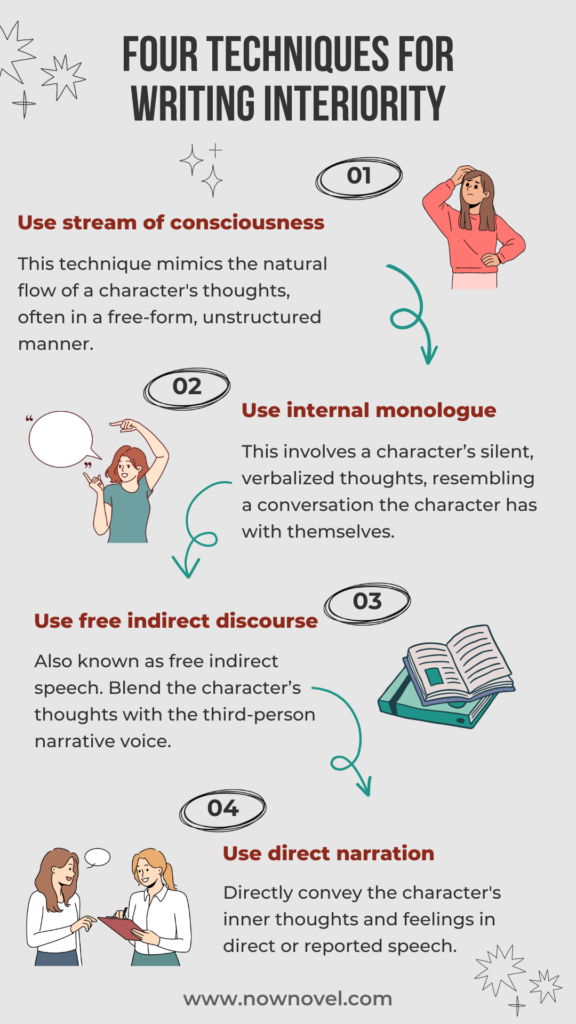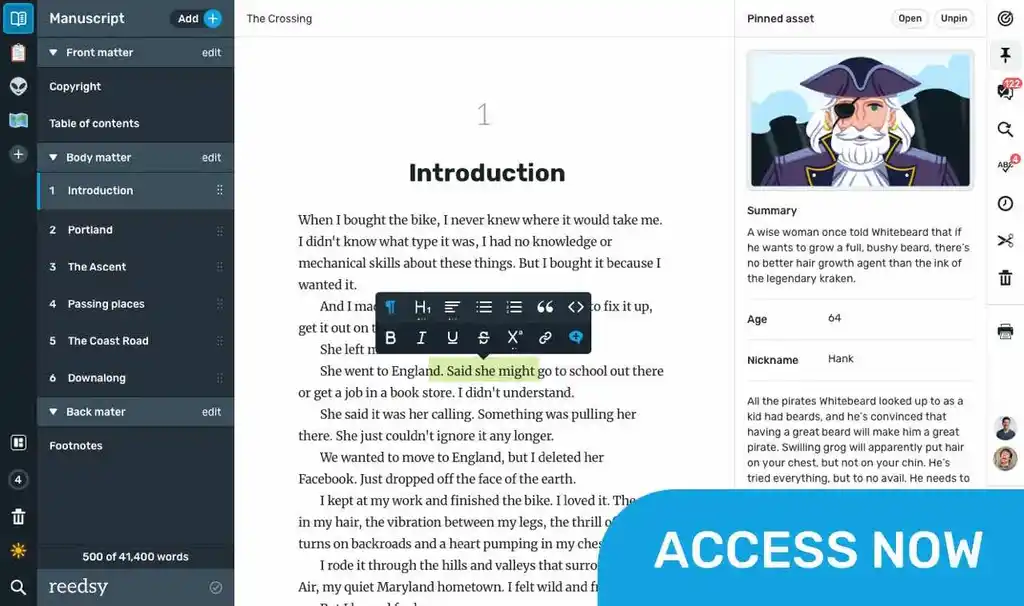Fiction provides a window into the lives, thoughts, and emotions of characters. One of the most powerful tools a writer has in their arsenal to achieve this is the use of interiority. Interiority, or the depiction of a character's inner thoughts and feelings, allows readers to step inside the minds of characters and experience their personal landscapes.
This allows readers to empathise, sympathise and become fully immersed in the lives of characters and the worlds they inhabit. Let’s not forget that you can use this technique in other types of writing, such as memoirs. Although you’d think that you would automatically be granted access to a person’s thoughts and motivations if they are writing such a piece, some memoirs do little more than recount a series of the events in their lives, without telling us why they did such and such, or met so and so.
Books are a wonderful to provide interiority – an aspect that is not as easily achieved with film or plays, for example. With those mediums a voice-over of a character can reveal character, or a character writing in a diary, with the words displayed on screen, or in a voice-over, or a character talking to another. I mention these as these are also all techniques that you can use in your fiction (and memoir) writing. But let’s take a deep dive into interiority.
What is interiority?
Interiority refers to the narrative technique that reveals the inner life of point-of-view character. This means their thoughts, feelings, emotions and unspoken reactions.
Unlike dialogue, which is external and shared with other characters, interiority remains internal and private, often providing a stark contrast to a character's outward actions and spoken words. However, as I mentioned above, you can use dialogue to express a character’s inner world.
Generally, interiority means seeing and experiencing the world from their point of view, showing the reader why a character has acted this way, what motivates them and drives them, and how that leads to the actions that they take.
Some writers use too little interiority – and some too much.
The dangers of using too little interiority is that you can produce a manuscript that is full of dialogue and action, so that the reader sees the action almost as if they were in a film, but does not know why such a character is motivated to do whatever it is they are doing. The problem is that this means the reader might not care at all about the character and will drop the story.
You always have to make a reader care and/or understand what a character’s motivations are, to ‘introduce’ them thoroughly to a character, and interiority is one of your greatest tools to do so.
You will require a deep understanding of your character’s personality and background, remaining true to your character’s unique voice, and fears and motivations. We have tips to developing characters.
On the other hand, too much interiority can also be a problem. If you have a character who wanders through a novel thinking all the time, you might find that your novel lacks pacing and action, becoming bogged down in thoughts or overly introspective. Balancing interiority with action and dialogue is crucial to maintaining narrative momentum and reader engagement or your novel could become let’s whisper the word: boring.
So there’s a fine line to tread here.
Now Novel coach and seasoned fantasy and horror author, Nerine Dorman speaks of interiority as the ‘glue’ between the outside and the inner world:
Having access to the character's inner landscape creates the glue between the stuff that occurs in the outside world vs what's going on in the character's head – so we deepen point of view but also create a better lens for readers to view the world, thereby giving particularity. Understanding the character's motivations and how what they do or say is informed by, but also effects change around them.
Other reasons to include interiority include the fact that writers can create multi-dimensional characters by diving deep into their heads. By gaining insight into motivations, fears, desires, and contradictions that drive the character’s actions means that characters feel real and relatable.
Interiority allows readers to connect emotionally with characters. Understanding a character's internal struggles and joys fosters empathy, drawing readers more deeply into the story. And keeping them there.

Are you exploring a particular theme in your story? Are you looking at the inhumanity of slavery or the effects of colonialism, for instance? This is an excellent way to explore such complex themes and ideas. A character’s reflections on events and interactions can provide a fascinating commentary on broader societal, philosophical or psychological issues.
And then there’s plot development: interiority can advance the plot in subtle yet significant ways. A character’s inner conflicts and decisions often propel the story forward, creating suspense and anticipation.

Examples of interiority
Really understanding interiority means taking a look at some examples from literature. One of the earliest chroniclers of interiority in novels comes from Jane Austen. She used a third person omniscient voice, but inhabited character to show what they were thinking, reacting and feeling. Here is an example from Austen’s Pride and Prejudice, showing the thoughts of Elizabeth Bennett first arriving at Pemberley House:
Elizabeth, as they drove along, watched for the first appearance of Pemberley Woods with some perturbation; and when at length they turned in at the lodge, her spirits were in a high flutter. The park was very large, and contained great variety of ground. They entered it in one of its lowest points, and drove for some time through a beautiful wood stretching over a wide extent.
Elizabeth's mind was too full for conversation, but she saw and admired every remarkable spot and point of view. ...
Elizabeth was delighted. She had never seen a place for which nature had done more, or where natural beauty had been so little counteracted by an awkward taste. They were all of them warm in their admiration; and at that moment she felt that to be mistress of Pemberley might be something!
Use internal monologue: this involves a character’s silent, verbalized thoughts. Unlike stream of consciousness, it is more structured and coherent, resembling a conversation the character has with themselves.
Writing a century after Austen, Virginia Woolf was another pioneer of revealing the interior thoughts of characters, along with James Joyce and others. They used a stream of consciousness technique. Here is Woolf in Mrs Dalloway, showing the titular character's feelings of being swallowed by her position as a married woman in society:
But often now this body she wore (she stopped to look at a Dutch picture) this body, with all its capacities, seemed nothing—nothing at all. She had the oddest sense of being herself invisible; unseen; unknown; there being no more marrying, no more having of children now, but only this astonishing and rather solemn progress with the rest of them, up Bond Street, this being Mrs Dalloway; not even Clarissa any more; this being Mrs Richard Dalloway.
James Joyce shows the jump and jumble of Leopold Bloom’s thoughts in Ulysses:
He smiled, glancing askance at her mocking eye. The same young eyes. The first night after the charades. Dolphin’s Barn. He turned over the smudged pages. Ruby: the Pride of the Ring. Hello. Illustration. Fierce Italian with carriagewhip. Must be Ruby pride of the on the floor naked. Sheet kindly lent. The monster Maffei desisted and flung his victim from him with an oath. Cruelty behind it all. Doped animals. Trapeze at Hengler’s. Had to look the other way. Mob gaping. Break your neck and we’ll break our sides. Families of them. Bone them young so they metempsychosis. That we live after death. Our souls. That a man’s soul after he dies. Dignam’s soul…
A more contemporary example is found in Alice Walker’s The Color Purple, which is centered on Celie:
It took him the whole spring, from March to June, to make up his mind to take me. All I thought about was Nettie. How she could come to me if I marry him and he be so love struck with her I could figure out a way for us to run away. Us both be hitting Nettie’s schoolbooks pretty hard, cause us know we got to be smart to git away. I know I’m not as pretty or as smart as Nettie, but she say I ain’t dumb.
For more examples of novels that use interiority, have a read of novelist Claire Messud's recommendations.
Techniques for writing interiority
Firstly, interiority is best used in first or third person point of view – and these are the most commonly used POVs used in fiction. That’s not to say that you can’t express it in second or fourth point of view, although with fourth you are looking at expressing the thoughts of a collective ‘we’.
Use stream of consciousness: this technique mimics the natural flow of a character's thoughts, often in a free-form, unstructured manner as we can see in Joyce’s Ulysses and Woolf’s Mrs Dalloway are prime examples of this approach, and use third POV.
Use internal monologue: this involves a character’s silent, verbalized thoughts. Unlike stream of consciousness, it is more structured and coherent, resembling a conversation the character has with themselves. The Color Purple is structured as ‘letters to God’, it is both in first POV and reads like a monologue. Read our comprehensive post on internal monologue.
Free indirect discourse, also known as free indirect speech blends the character’s thoughts with the third-person narrative voice. It allows for a seamless integration of interiority into the overall narration. Austen often employed this method as we have seen. This also allows the writer to roam from character to character, showing all their thoughts, and is excellent for multi-person narratives.
Direct narration: Here, the narrator directly conveys the character's inner thoughts and feelings. This can be done in both first-person and third-person narratives. This is done via dialogue, either direct, using quotes or other speech markers, or can be done via reported speech.










I love this article, which should be the shot in the arm I need to make a stronger connection to the protagonist and the antagonists who will be in the spy series I will soon begin writing. Your articles are so helpful to my fiction writing and my author website.
Todd Hicks - Over 1 year ago
Thanks so much for your comments, Todd. I'm so pleased to know that our blog posts are helpful. Interiority in fiction is necessary, but there's also a fine line to tread between using too much, or too little. Interiority refers to the narrative technique that reveals the inner life of point-of-view character. The key to using interiority is balance. Too much interiority means that your character is doing too much thinking and there might not be enough action and dialogue, for example. You need those elements to keep a story going, and readers engaged. If you have too little, readers won't know what a character's motivations are, might not care at all about the character and may drop the story.
Arja Salafranca - Over 1 year ago